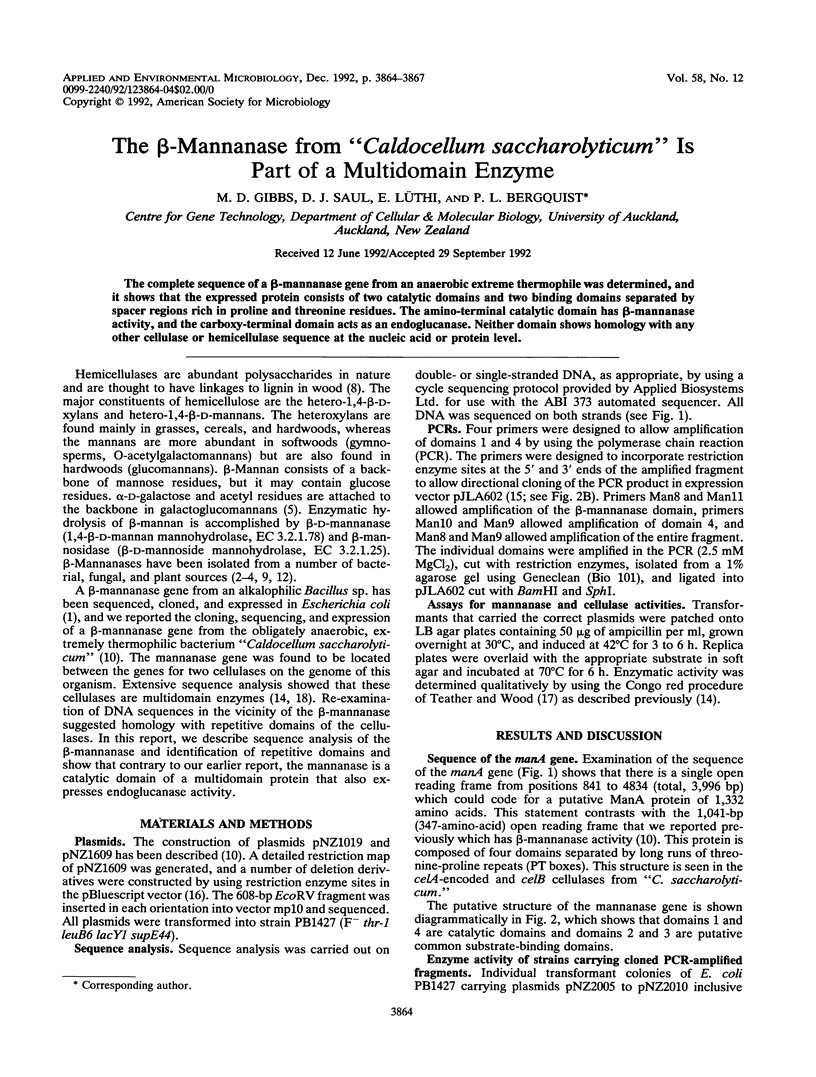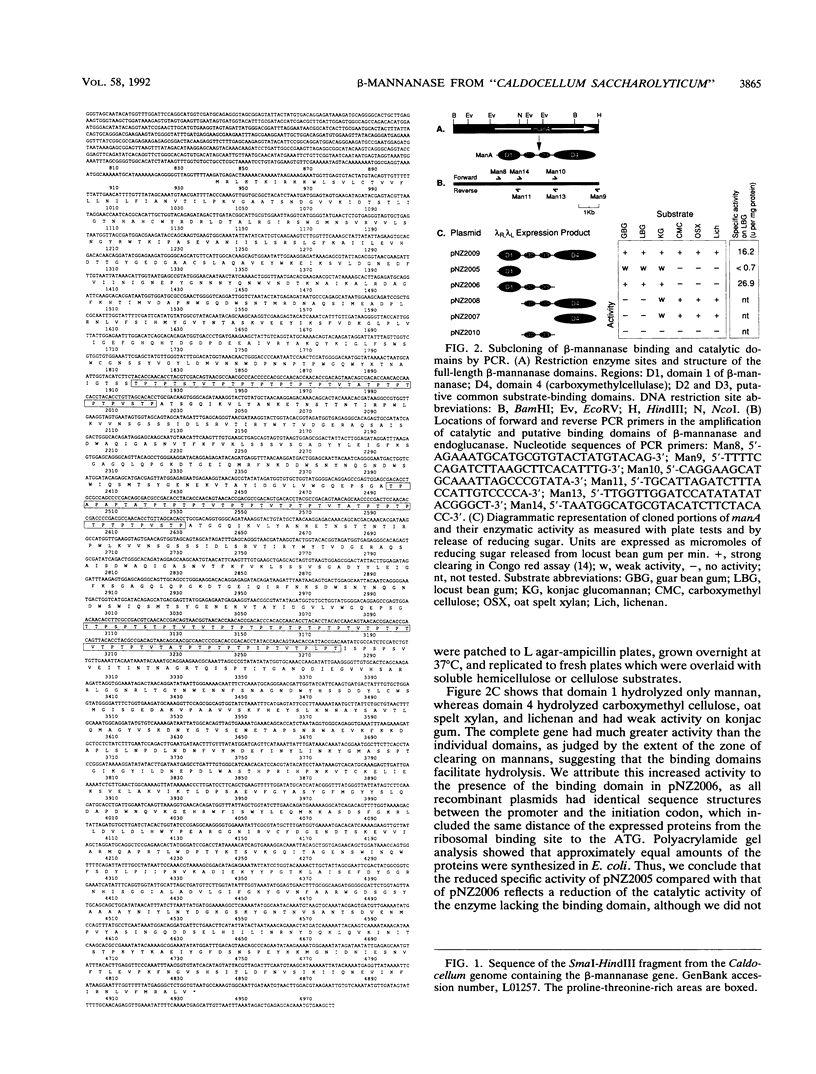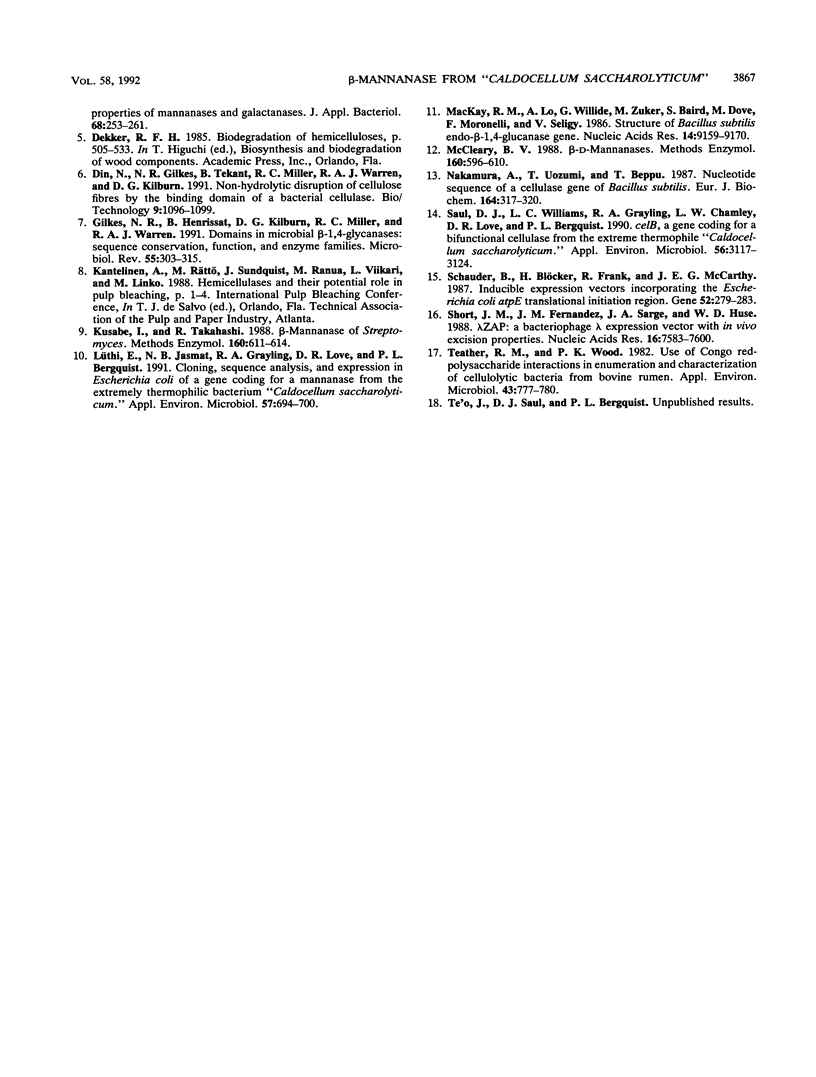Abstract
The complete sequence of a beta-mannanase gene from an anaerobic extreme thermophile was determined, and it shows that the expressed protein consists of two catalytic domains and two binding domains separated by spacer regions rich in proline and threonine residues. The amino-terminal catalytic domain has beta-mannanase activity, and the carboxy-terminal domain acts as an endoglucanase. Neither domain shows homology with any other cellulase or hemicellulase sequence at the nucleic acid or protein level.
Full text
PDF



Selected References
These references are in PubMed. This may not be the complete list of references from this article.
- Akino T., Kato C., Horikoshi K. Two Bacillus beta-mannanases having different COOH termini are produced in Escherichia coli carrying pMAH5. Appl Environ Microbiol. 1989 Dec;55(12):3178–3183. doi: 10.1128/aem.55.12.3178-3183.1989. [DOI] [PMC free article] [PubMed] [Google Scholar]
- Araujo A., Ward O. P. Hemicellulases of Bacillus species: preliminary comparative studies on production and properties of mannanases and galactanases. J Appl Bacteriol. 1990 Mar;68(3):253–261. doi: 10.1111/j.1365-2672.1990.tb02572.x. [DOI] [PubMed] [Google Scholar]
- Gilkes N. R., Henrissat B., Kilburn D. G., Miller R. C., Jr, Warren R. A. Domains in microbial beta-1, 4-glycanases: sequence conservation, function, and enzyme families. Microbiol Rev. 1991 Jun;55(2):303–315. doi: 10.1128/mr.55.2.303-315.1991. [DOI] [PMC free article] [PubMed] [Google Scholar]
- Lüthi E., Jasmat N. B., Grayling R. A., Love D. R., Bergquist P. L. Cloning, sequence analysis, and expression in Escherichia coli of a gene coding for a beta-mannanase from the extremely thermophilic bacterium "Caldocellum saccharolyticum". Appl Environ Microbiol. 1991 Mar;57(3):694–700. doi: 10.1128/aem.57.3.694-700.1991. [DOI] [PMC free article] [PubMed] [Google Scholar]
- MacKay R. M., Lo A., Willick G., Zuker M., Baird S., Dove M., Moranelli F., Seligy V. Structure of a Bacillus subtilis endo-beta-1,4-glucanase gene. Nucleic Acids Res. 1986 Nov 25;14(22):9159–9170. doi: 10.1093/nar/14.22.9159. [DOI] [PMC free article] [PubMed] [Google Scholar]
- Nakamura A., Uozumi T., Beppu T. Nucleotide sequence of a cellulase gene of Bacillus subtilis. Eur J Biochem. 1987 Apr 15;164(2):317–320. doi: 10.1111/j.1432-1033.1987.tb11060.x. [DOI] [PubMed] [Google Scholar]
- Saul D. J., Williams L. C., Grayling R. A., Chamley L. W., Love D. R., Bergquist P. L. celB, a gene coding for a bifunctional cellulase from the extreme thermophile "Caldocellum saccharolyticum". Appl Environ Microbiol. 1990 Oct;56(10):3117–3124. doi: 10.1128/aem.56.10.3117-3124.1990. [DOI] [PMC free article] [PubMed] [Google Scholar]
- Schauder B., Blöcker H., Frank R., McCarthy J. E. Inducible expression vectors incorporating the Escherichia coli atpE translational initiation region. Gene. 1987;52(2-3):279–283. doi: 10.1016/0378-1119(87)90054-0. [DOI] [PubMed] [Google Scholar]
- Short J. M., Fernandez J. M., Sorge J. A., Huse W. D. Lambda ZAP: a bacteriophage lambda expression vector with in vivo excision properties. Nucleic Acids Res. 1988 Aug 11;16(15):7583–7600. doi: 10.1093/nar/16.15.7583. [DOI] [PMC free article] [PubMed] [Google Scholar]
- Teather R. M., Wood P. J. Use of Congo red-polysaccharide interactions in enumeration and characterization of cellulolytic bacteria from the bovine rumen. Appl Environ Microbiol. 1982 Apr;43(4):777–780. doi: 10.1128/aem.43.4.777-780.1982. [DOI] [PMC free article] [PubMed] [Google Scholar]


